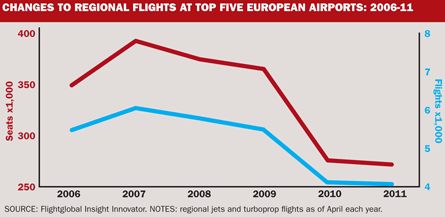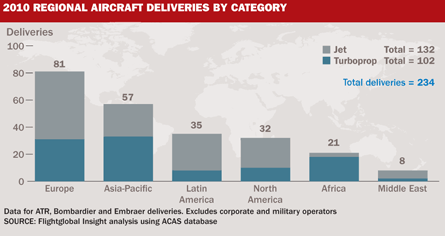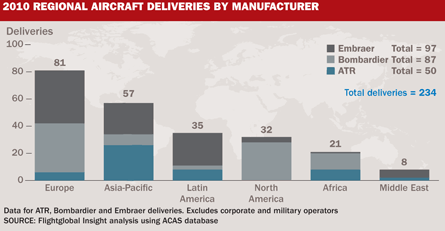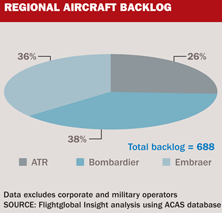The numbers paint a stark picture. Over the past five years, the number of flights operated by regional aircraft into Europe's five busiest hubs - London Heathrow, Paris Charles de Gaulle, Frankfurt, Madrid and Amsterdam - has plummeted by 34%. But is this change caused by slot constraints, commercial viability or is it just a side effect of increasing average aircraft size?
"Regional operators are being squeezed out of some hubs, but not others," says Simon McNamara, deputy director general at the European Regions Airline Association. "The fundamental problem is a shortage of capacity." He describes regional airlines as the "first casualty" of this capacity crunch.
Heathrow, which is bulging at the seams, is the worst affected. "You really need to differentiate Heathrow from the others," says Olivier Jankovec, director general of ACI Europe. "I don't think we will see that situation at the other major hubs - they still have spare capacity, so it's not a problem - but depending on how this develops, it could become a problem in the next 20 years."
 |
|---|
In April 2011 Heathrow will handle just 283 regional aircraft sectors, 11.6% down on five years ago. This compares with 1,244 at Paris, 666 at Frankfurt, 1,380 at Madrid and 396 at Amsterdam.
"Airports see runway use as a way to maximise their aircraft throughput, passenger numbers and therefore revenues," says McNamara. And although regional aircraft typically pay more per seat than larger types, they deliver fewer passengers to the terminal and generate less non-aeronautical revenue. In short, it is more valuable for the airports to accept larger aircraft.
McNamara adds:. "Underlying the reduction in regional services is a fundamental shortage of capacity, which means that airports adjust their commercial policies. Depending on the proportion of cost that the airport charge represents, it is quite possible that could tip the balance between whether a route is profitable or not," he says.
Ultimately for the airlines it is about maximising a scarce resource. So, although flights operated by regional aircraft at Heathrow dropped 11.6% over five years, the number of seats declined only 0.3%.
SHIFT TO LARGER AIRCRAFT
"In a constrained situation the pressure on airlines to use the most profitable tools and solutions is increased," explains Bombardier Commercial Aircraft director of international marketing Frederic Morais.
"What this has created is a shift towards larger regional aircraft. For airlines it comes down to matching demand with the most optimal, profitable solution," he says. Over the next 20 years Bombardier sees demand for 5,900 aircraft deliveries in the 60- to 99-seat category, compared with just 200 in the 20- to 59-seat range.
 |
|---|
|
|
|---|
"We see a clear shift in demand," says Morais. Bombardier has responded to these changes by building larger aircraft, gradually increasing the capacity of its CRJ family and ultimately moving into the single-aisle field with its larger CSeries, which is scheduled to debut in 2013.
"At the same time as we are seeing growth towards larger regional aircraft, we are seeing a similar trend towards larger single aisles," says Morais. Single aisles tend to be optimised around larger models, therefore Bombardier is looking to tap the trend towards larger regional aircraft, designing the CSeries as more of an entry-level single-aisle aircraft.
Each manufacturer is keen to stress how their own equipment solves the congested hub dilemma. ATR pushes the operating economics of turboprops, Bombardier offers a full range of size and propulsion options, while Embraer is now focused on the upper end of the regional spectrum.
Luiz Sergio Chiessi, Embraer vice-president market intelligence - airline market, says: "According to OAG, the number of flights in the 30- to 60-seat jet segment was reduced from 7% to 5% of the total flights in the major European hubs - Heathrow, Charles de Gaulle, Frankfurt, Madrid, Barcelona and Amsterdam - from 2000 to 2010. Over the same period the 61- to 90-seat jet segment increased its share from 5% to 7%." Embraer's 170/175 is therefore a good fit that caters for this trend, says Chiessi.
Although capacity may be moving up the scale, regional flights still represent some 38% of worldwide departures, according to OAG data. At slot-restricted airports, this number drops to 25%, which still represents a large chunk of traffic. "Regional aircraft are essential for airlines to keep a diversified feed to their hubs and generally tend to capture higher yield traffic," says ATR head of sales John Moore.
He adds the average capacity of regional flights at slot-restricted airports is 62 seats, versus 57 worldwide. "This confirms the fact that airlines tend to place slightly larger-capacity aircraft on these markets. The trend towards increasing capacity at a slot-restricted airport is one of the factors that led ATR to consider a larger turboprop."
The upsizing trend may be evident at Heathrow, which is indicative of its congestion problems. The overall trend is towards fewer regional aircraft flights and regional capacity at the five major European hubs (see chart).
Over the five-year period, Paris registered a 28.8% drop in regional aircraft movements and a 29.5% drop in regional capacity. Frankfurt posted a 57.6% plummet in flights and 61.1% less capacity. Similarly, Amsterdam's flights were 63% down and capacity was 50% lower. The only airport in the top five to buck this trend was Madrid, where movements were up 2.7% and capacity was up 10.5%.
FEEDER ROLE
This pressure on regional airlines worries McNamara and ERA's member. "This does concern us, very much so." He says regional services play an important hub feeder role.
"Long-haul feeding long-haul has become the case at many airports like Dubai and Doha, rather than short-haul feeding long-haul networks," he says. "For our members it is important to gain access to hub airports because it allows people to connect to European capitals while working from the regions."
Maintaining a competitive transport network, regional development and connectivity are key priorities for the European institutions and McNamara says EU regulators and politicians understand ERA's position. But he adds: "The European air transport industry is fully deregulated. Route decisions are driven by commercial rather than political reasons."
 |
|---|
BAE Systems Regional Aircraft senior vice-president for sales and marketing Steve Doughty says it comes down to what value governments place on continued availability of regional services.
"Governments of either colour have shown no appetite for interfering with free market economics. If there's no imperative, airlines will do what's most profitable for them. At busy airports that will mean pushing out less-profitable aircraft," he says.
Because capacity is the crux issue, McNamara stresses how important it is to maximise use of existing runways and invest in future infrastructure projects. "Slot allocation regulation is also very important in maintaining regional access to hub airports," he says.
Under existing regulations, regional airlines are entitled to keep their slots, even at the most constrained airports, so the only decider is whether it works for them commercially. But Europe is likely to review its slot regulation towards the latter half of this year as part of its airport package. McNamara is hoping that little will change. "We believe the existing policy is fair because it doesn't discriminate based on aircraft type."
The other solution, flagged by Madrid Barajas airport head of operations Ignacio Aznar Hercilla, is intermodality. This is another pet subject among EC politicians and a key theme in Europe's new 10-year transport policy, which will be finalised later this year.
Aznar Hercilla says pressure on regional services concerns Spain's Aena, both as an airport operator and a slot allocation agency. "Traditional point-to-point regional services will become extinct in main hubs unless regional aviation terminals are built and special slot allocation procedures are applied," he says.
- Read our analysis of the challenges facing the European airline sector
Source: Airline Business





















